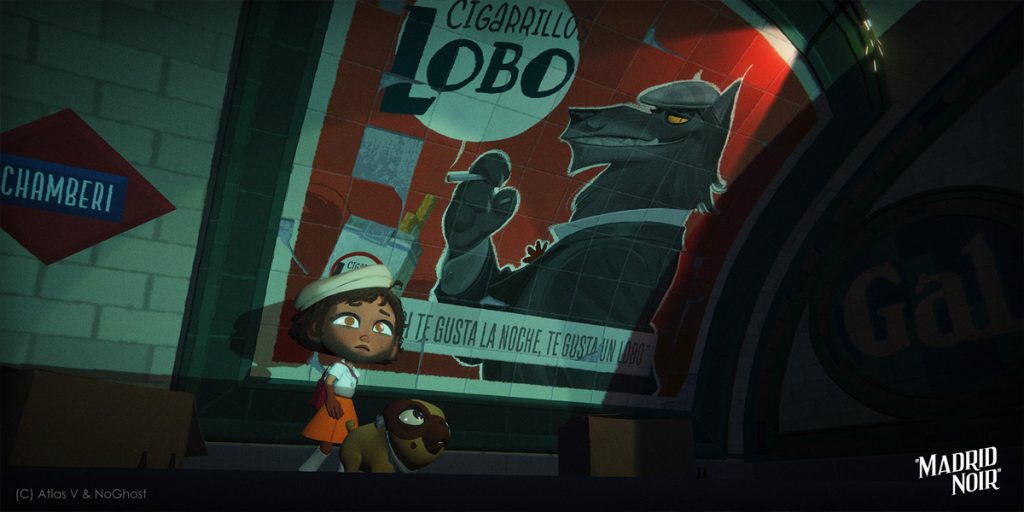Ahead of Madrid Noir ‘s World Premiere at Tribeca, director James A. Castillo tells us about developing an immersive Virtual Reality experience that feels like a classic noir but comes alive with irresistible animation and a strong emotional core.
Madrid Noir is the kind of Virtual Reality experience you only come across very rarely. Developed into a longer experience from director James A. Castillo ‘s Award-winning 2018 VR short Madrid Noir: Prologue, which followed a retired detective living a quiet life in Madrid with his 9-year-old niece, this genre-bending adventure revolves around the same characters but takes place over multiple timelines, and places the viewer right in the middle of a mystery to solve. Madrid Noir‘s charming protagonist is the same girl from Prologue, but she’s not 9 years old anymore. Lola Petit (Godeliv Van Den Brandt) has grown into an empathetic, fierce young woman who’s having to deal with the many expectations placed upon her by society, and who’s trying to find herself in the middle of it all. When we first meet her, she has just arrived in Madrid to empty her estranged uncle’s apartment, as detective Manolo Monreal (Fernando Guillén Cuervo) has recently been declared dead. But the many objects from their past together prompt her to take a trip down memory lane and try to solve the puzzle that was her uncle’s life – a puzzle whose pieces she’ll find hidden within her own memories.
If Madrid Noir‘s compelling, multilayered narrative is part of what makes it so gripping and unique, it’s not the only reason for its success. This adventure was made to be experienced in Virtual Reality, and, as such, it’s as immersive as can be. Thanks to strategically placed moments of interaction that have us right by Lola’s side from the very first moment we meet her, giving us an active role in her search for answers, we’re always invested in a story that never fails to feel like a journey, both narratively and emotionally. As Lola takes us back in time, we see Manolo’s flat come to life in the very real memories we share with her, and a sense of familiarity strangely sinks in, ready to pull at our heartstrings at the most opportune moments. But that’s not all.
The authenticity and attention to detail that defines Madrid Noir‘s characters and narrative arc is also very much tangible in its style, setting and atmosphere, conjuring a mood that is unmistakenly reminiscent of classic noir films, but also very much its own thing. Madrid Noir comes alive by means of gorgeous animation, stunning saturated colours, irresistible sound design and incredible attention to setting, with a framing device that sets the mood, giving it the feel of a live theatre production. There are hints of The Pink Panther and Double Indemnity in this noir mystery, but there are also the vividness of animation, the theatricality of the West End, a Madrid like we’ve never seen before, and a meaningful coming-of-age story that’s bound to draw parallels to Pixar’s Inside Out.
During Madrid Noir‘s festival run at Tribeca and Annecy, and ahead of its worldwide release on the Oculus Store on July 1st, 2021, we spoke with director James A. Castillo about this one-of-a-kind experience. Here’s what he told us about how Madrid Noir came to be, combining noir aesthetics with a strong sense of setting and a unique visual identity, the theatrical and emotional components brought by Virtual Reality, the challenges and creative choices faced by the team, and more.
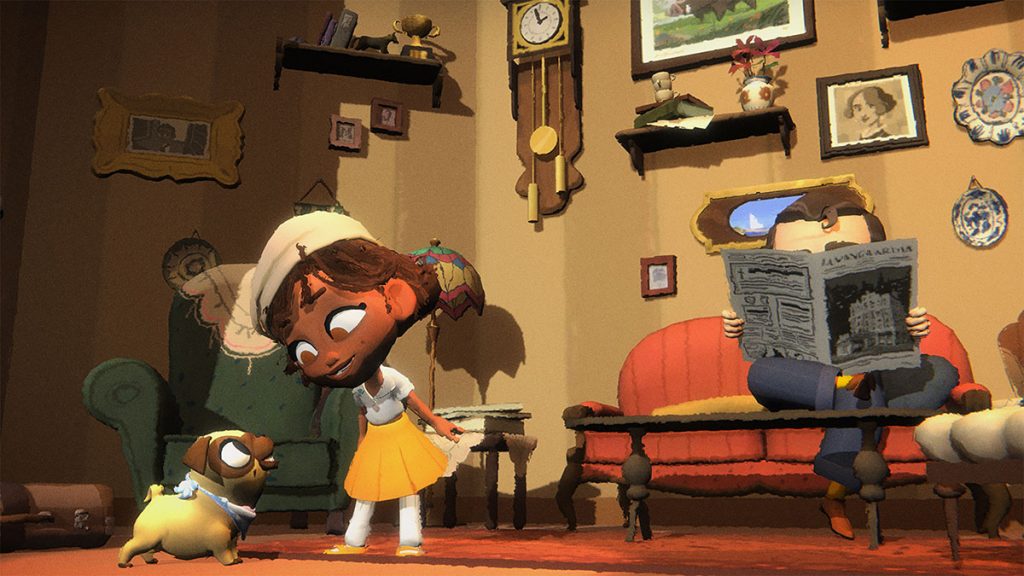
Showing Madrid Noir to the World
Thank you for talking to us, and congratulations for Madrid Noir‘s World Premiere at the Tribeca Film Festival! I know you’re currently at two festivals, as you’re also about to attend the Annecy International Animation Film Festival!
JC: Thank you! I know, it’s an amazing honour. I have a special relationship with New York and I was really looking forward to attending Tribeca, but, if you don’t have a US passport, you can’t enter the US right now, so we weren’t allowed to go in person. So I thought, well, ok, if I’m not going to New York, I’m not going to miss Annecy, no matter what. That’s why I came to France a little bit early, because I had to sort out COVID quarantine before going to the festival. I guess, like any other festival right now, it’s going to be a little bit different and surreal, and there are going to be less people, but I needed to go. I needed to experience our baby being seen and appreciated by all these people, you know?
… And it deserves all the appreciation, because Madrid Noir is amazing! What does it feel like to be able to finally show it to people?
JC: You’re very kind. Every step of the production was an absolute surprise and delight. This whole thing started with me doing a drawing four years ago, on a bus! And then, with a lot of work, and people joining in, it has become this thing. It was never the intention of this to become a 45-minutes-long, Oculus-exclusive film. It was an idea, and, when it started growing, I was just trying to make sure that it wasn’t growing in the wrong direction. I’ve been so close to it, but I have very little perspective, so what you’re saying is touching, because it’s echoing all these things that we were trying to achieve, early on, and that’s why I’m really appreciative of it.
So how did Madrid Noir go from being a drawing on a bus to the experience it is now?
Myself and the team from No Ghost did the short film [Madrid Noir: Prologue] together, and we were talking about what to do next. There was always an intention of creating something that existed in a world where a lot of projects don’t dare to go to, in VR, as they usually want their project to be either a film or a game. I feel that, at this point, VR is so good at being the thing in between. Everybody’s trying to not be the thing in between, so I thought, let’s just do that: let’s try to be the thing in between. How can we create a narrative that allows VR to actually shine, and not be something that’s in the way, for the audience? So, all those conversations, and all those long nights trying to fill out the story, and all those discussions about interactivity… I still don’t know if we succeded: I’ve seen it, like, 150 times, so I can only see all the versions of the story that don’t exist, and all the things we couldn’t do. Hopefully people will appreciate it!
Creating Madrid Noir, and Having Lola Tell Her Own Story
How long did it take you to make Madrid Noir?
I believe the first ever drawing of Manolo is from 2016. It took me about six months to a year to make it into something that was a little bit more tangible, and another eight months to a year to make the short film. And then it took a year to sell it, and a year and a half to make it. This is our first time entering into this independent development funding process, so we learned as we went with the production. So, we’ve been carrying this for a good four years or so.
Madrid Noir: Prologue was about Lola’s uncle, Manolo. How did you get the idea to make Madrid Noir revolve mainly around Lola, whom we meet at two different stages of her life?
JC: There are a lot of things that pushed us in that direction, and I have to credit writers Lawrence Bennett and Lydia Rynne, because I came in with a very clear idea of the themes, style and plot, but the process of creating the characters as they stand right now is heavily on them. The Prologue was almost like a Pink Panther type of thing: we had a hero and a bad guy; the bad guy kidnaps the puppy of the hero, and the hero goes and rescues it. It was a very straightforward storyline, and the idea, at first, was to make these little comedic short films where it was all about the crazy situations that we could create to allow for comedic action. But then, as creative people do, we started being more ambitious. And, as we started to get sort of seen by producers and bigger brands, we thought, ok, let’s go as big as we can.
So we went into the room with a very crazy idea: we wanted to create a noir, we wanted to create a mystery, we wanted to do it in VR and we wanted it to be interactive. Now, we tried very hard to make the interactions work, but they were a mess, and they always felt gimmicky. For a long time, we were thinking of having viewers pull a lever, and the light would turn on, or a prop would come up, or something like that. And then it felt like none of those interactions had any emotional value: they didn’t feel very genuine. We also knew that, because we wanted to do something longer, we couldn’t just have a bad guy, a detective and a dog: we needed to have a character that Manolo needed to have a conflict with.
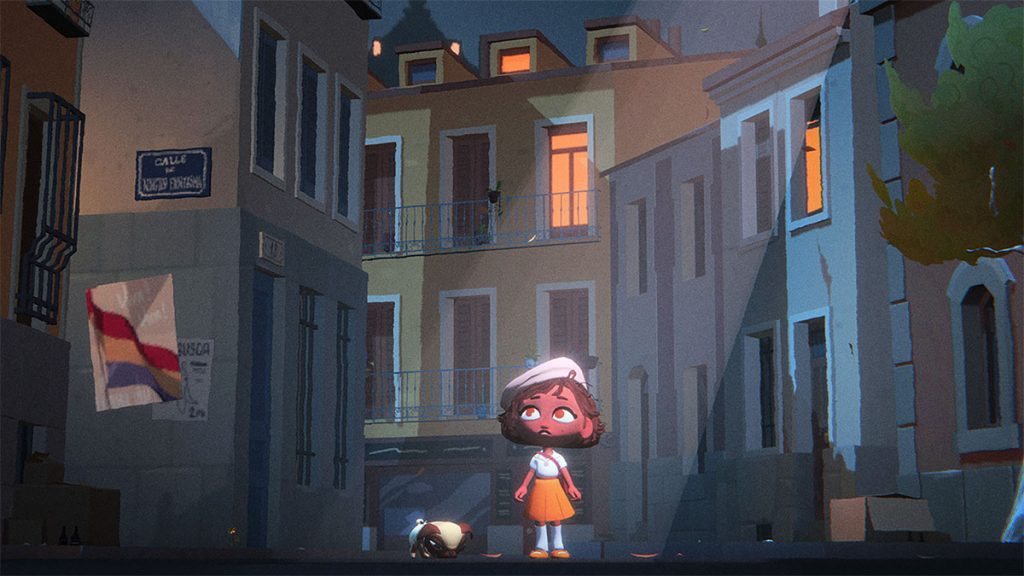
And so, we designed Lola, as a little girl, at first. We thought, what’s the the absolute opposite that we can create to this grumpy, older man that is stuck in his ways and has a very constructive way of seeing the world? The most alive, curious, active, rebellious, little girl. But then, as we tried to build this mystery and create a story around Manolo, we found it very hard to to make him the protagonist, in the sense that he didn’t have an arc. We only knew that he was a detective, that his niece got kidnapped at one point, and that he had to rescue her because he loved her very much. It was almost like a way of raising the stakes, but Manolo stayed the same person throughout the whole story. And we started to realise that it would have been much more interesting to see the perspective of Lola, and to have her tell you the story, because we always knew that the narrator was going to be an older Lola.
And then, one of those days, at, like, midnight [laughs], there was a lightbulb moment where we thought, wait. What if you were actually interacting with Lola in the present, and we used those moments for the interaction, and then, when she told you the story, you could just relax and watch? But Lola in the present also needed to have her own conflict, which is not believing in herself and being trapped in a situation, which is what Lydia [Rynne] brought to the character: Lola needed to be a woman that felt trapped in the constraints of our social dynamics, and she needed to have something to learn from her younger self. So, we created a character that’s kind of shy: like, she’s expected to get married and to do a lot of things, but she also wants to pursue her dreams.
Lola’s Narrative Arc: Learning From Our Younger Selves
I feel that the narrative frame gives the story a lot of emotional depth. I love that Lola grows a lot during the experience too, from remembering her younger self.
JC: That’s true. When she starts to remember what happened with Manolo that summer, and she sees herself taking all these risks and being fearless, she realises that she has lost herself while she was growing up, and she gets inspired by her younger self to pursue her dreams. That’s a much more interesting story to tell than that of a grumpy old man who rescues her little girl. That created a very interesting dynamic, where the player would first meet Lola being older, and you’ll be like, “Oh, I don’t you know you”. You might not necessarily find her unlikable, but you might not understand where it’s all coming from, with all these feelings she’s telling you about: you might not get it. And then, once you see the story, and once you go back to the apartment to see her again, … All of a sudden, this one-note character has all these layers, because you’ve seen her being a child. That’s where the protein is, right? That’s where the magic happens, when you can tell a story like that, and people get it.
That’s so true! And I also love how Lola’s relationship with Manolo evolves during her journey.
JC: Yes, this process allowed us to make Manolo a much more mysterious character. Because part of the experience is Lola’s internal journey, and then there’s the mystery itself. At the beginning, we thought the mystery was going to be surrounding a mysterious character that was never introduced, but then we realised that Lola needed to realise that what she remembered from her childhood was not the actual truth. That allowed us to make Manolo a much deeper character: having Lola realise, all of a sudden, that what she thought to be true about her uncle for 20-something years was not, is much more interesting as a reveal. And plot-wise, as a writing team, we started this in our late 20s, and we’re now all in our early 30s. So we realised that we were all going through a process of recontextualizing our childhood, which is a very universal thing: once you’re an adult, you understand situations in a way that you couldn’t when you were a kid, and, the more you start contextualising memories, the more you begin to confront the truths you had made up in yout mind, and realise that they were never 100% true, because there were grey areas to all of that. So we thought that this would be a good mechanism to follow, for Lola’s to be a coming of age story. As writers, we understood the feeling, and we felt that made the story more universal.
The Emotional Power of Storytelling and Virtual Reality
Even if my brain knew that this wasn’t a live experience, I found myself actually replying to Lola when she was speaking to me, forgetting that she couldn’t hear me! I felt like she knew exactly what I was doing, because the story is so immersive. It definitely feels to me like this project could only have been made in Virtual Reality.
JC: Totally. Absolutely. I wish I had somebody here that I could high five, as that was the idea of it! [laughs] I always find myself saying thank you to [Lola], whenever she asks me to do things. When people try to describe the the power of Virtual Reality as something that’s empathetic – even though I think it’s a bit of a buzzword, it’s because it really touches on this human instinct: VR can access a part of the brain that a normal movie, or a theatre play, cannot get to, because your suspension of disbelief is so big in VR. As the person telling the story, if you are able to play those strings and manipulate those moments, you can get a very good emotional reaction from the player. You try to capitalise on those moments, and you ask yourself, how can I create a situation where [Lola] feels more alive? For example, there’s a scene where, depending on what you do with a gun, she’ll react in a different way, which is based on the way you’d imagine a real person to react. I’m so interested in seeing people’s reactions to that moment. It’s situations like that where, for a split second, you’d question whether she was alive or not.
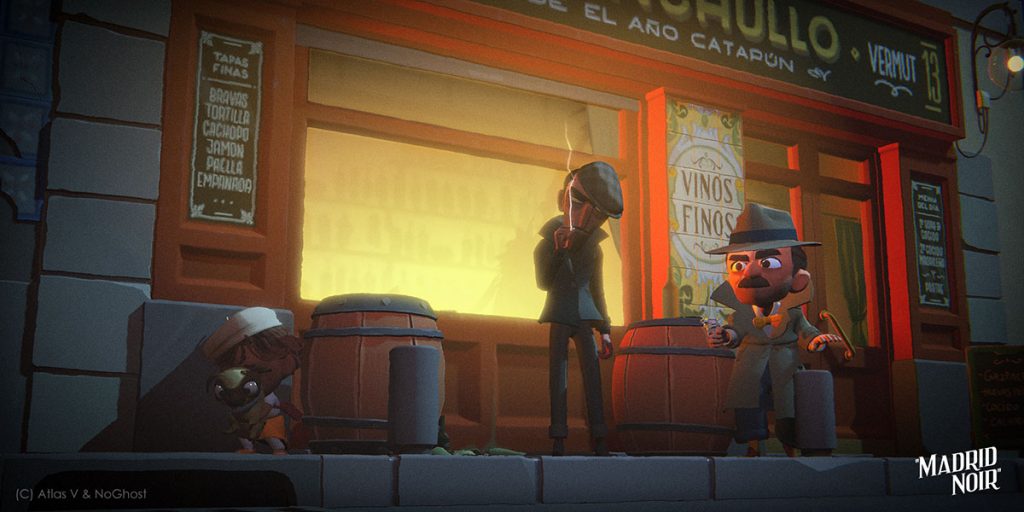
I love that! I also thought the ending was so meaningful: it made me so emotional! Without spoiling anything, there are certain details that reveal a lot about what’s about to happen, and those really got to me.
JC: That’s the hardest part. I have to credit Lawrence [Bennett] for that: I have an animation background, and some experience in VR. To me, a lot of this was about animation and storytelling. He was the one who wanted to make something that had a lot of heart. It needed to have it, because, otherwise this was just going to blend with everything else. Lawrence was very into the whole theatre idea: he fought really hard to make something that had a lot of emotional payback. There’s a moment where Lola is about to get to a door, and then takes a step back, and then knocks, and after a few seconds she’s about to turn. The animators did it so nicely, with the music and everything, and it’s one of those moments that made me feel very lucky to work with the people that I work with: I had to say very little, and all of them got it. They were like, I know exactly what this has to feel like. The team was, like, the Dream Team.
An Animated Noir Set in Madrid with the Theatricality of Virtual Reality
When did you know Madrid Noir was going to be in Virtual Reality?
JC: I had just finished art directing a project called Melita, which was produced by a studio called Future Lighthouse: that was my first ever contact with Virtual Reality. When I came out of that project, that’s when I started thinking that it was very cool. My first thought was, if we used theatre tricks, I think we could probably be much more effective in VR. I feel that, sometimes, certain VR projects try to force you to watch them as if you were watching a normal movie, for instance moving you around, and all that. I kind of felt like the medium and the storytelling were kind of fighting [in those projects], because you are so present in VR. In theatre, you are in the same space as the actors and the sets, and, already, 30-40% of the work is done for you: they already figured out how to set the stage, how to do the lighting, what to wear, and how to act in a way that can enable people in the background to see and understand the action. They’ve already figured out so many ways of using the art form, and I thought, if we can tap into that, I think we could make something cool in VR.
How did you come up with the genre?
JC: I’ve always been a big fan of genre in general, like science fiction, noir and such. Before directing this project, I’ve always worked as a character designer for animated movies and shows. I always felt that, if I was ever going to create anything in the animation-sphere, I’d want it to be a genre project, because it’s something I’ve always felt was lacking a little bit. So I knew that I had to have the theatrical component and noir aesthetics.
I feel like Madrid is also pretty much a character of its own. How did you come to choose it as a setting?
JC: When it came to the setting, my first reaction was to go to New York and Chicago, because those are the places where you will imagine police stories to take place. But I’m native from Madrid, and I’ve been living away from it since I was 20. At that point, I was going back very often, and I guess this happens to every immigrant: when you leave the place where you grew up, you’re normally tired of it. It feels tiny and boring, and you need to see the world. And then, when you do see the world and come back, you start realising that the city where you were born has nothing to envy London or Paris, or any other place. I was starting to become very appreciative of Madrid as a European city, and I thought to myself that it would have been much more genuine for me to tell a story in the city, because Madrid is unique to me. And, if anybody’s going to tell a story that’s set in Madrid, it really has to be someone from there. I also thought it would hopefully give it a bit of a different vibe, because 1930s people are very familiar with London and Paris, but I always felt like Madrid was a little bit more unknown. I hoped that it would work, and, to my surprise, it did, as people were saying that the setting weirdly makes [Madrid Noir] more exotic, because people don’t don’t just instantly have an idea of what that looks like.
Once I had those three things [the theatrical component of virtual reality, the noir aesthetics, and Madrid], I kind of felt like I had a board that could just move on its own. For example, in Spain, we have this thing called zarzuela, which is a type of pantomime theatre with very strong singing, and I thought, oh, that’s perfect! I’m going to take all of that, and that’s going to make it even more unique and specific. And we have all this music from the era that is like, kind of jazzy, but not a lot, and if we can do a hybrid of music that is like Spanish 30s with jazz, we can make a very genuine thing. And, in those years, Spain was about to go into a civil war, which is the perfect setting for a noir story. All of these things started to just come in, in a very organic way.
By the time we sat down to actually write the story, we had all the elements to figure it out. And, whenever we had a big question, we asked ourselves, how would a theatre play do it? And so, we went to the West End in London, to watch musicals and plays, and took notes. Like, “oh, look how they did that thing where a child actor goes into a wall and the older version of the same character comes out the other side!”. That was in Kinky Boots, for example. You see the way that they use the stage, and you realise that you don’t need to cut the scene to another place: you can just have the sets collapsing, and then appear again, or be different. All of these things just came together very organically.
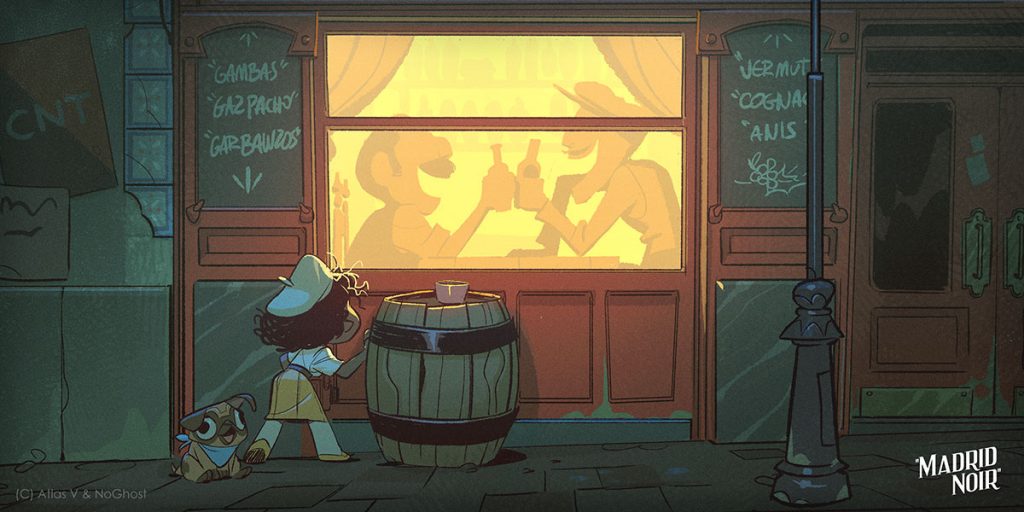
Madrid Noir‘s Atmosphere and Style: Creating a Different Kind of Noir
I love that Madrid Noir starts with us on our own, looking at files and playing a reel in a movie theatre. Why did you choose to have a framing device?
There was the idea of having you be a detective that has found a reel of this case that nobody has seen for a while, so you’re watching this very secretive thing. It’s also hard to create atmosphere, and we realised, when testing different ways to start the experience, that having an intro and an outro sets the tone. If you simply find yourself in the apartment and Lola comes in, you don’t know what you’re in for, and you don’t know what the tone is, or whether it’s a comedy or a drama: you don’t know anything. Creating that little moment at the beginning, where you’re investigating a case and putting the reel in, it tells you what you’re in for.
The aesthetics of it all are amazing too! How did you come up with this really unique style?
JC: Oh, that’s so nice of you! Well, because I have a background in design, I kind of set the style and tone of the project. When I create a project, most of the times I need a paragraph and an illustration, and that illustration normally has to embody a lot of aesthetic choices that would sort of determine the project. In this case, it took me a very long time, because noir stories tend to be, I don’t know, pretty grim, and black and white. I always knew that, as much as I wanted it to be a noir, I also wanted it to feel lively, and full of colour and life, and interesting. And so, once I started getting the characters right, it started to get a style. We took a lot of inspiration from the 1950s, like this designer called Ken Anderson, who’s most famous for doing production design for 101 Dalmatians.
It still had to feel graphic, and we were also aware that our lighting process was very limited: on Oculus Quest, you can’t add a lot of lighting because it takes too much CPU power. So this was a technical difficulty, as we couldn’t have too many lights, and we had to fake a lot of it. But because it was a noir, I needed to have at least one light that could give me shadows, which could establish mood, for instance by having the characters have a facial shadow. But that meant that we had to go for quite a graphic aesthetic, and be less realistic, so that the limited lighting wouldn’t make it look cheap: everything had to feel like an aesthetic choice.
There were three of us on the team: I did most of the character designs, then there was our production designer, Fanny Hagdahl Sörebo, and our art director, Juancho Capic, who’s also from Madrid. He came out with a lot of the “theatre logic” of the project, like, how far the props have to be, and how to keep them next to you with everything still being three-dimensional: that came through him. In Madrid, there’s a lot of text that’s written with a specific calligraphy, and he did everything by hand, and painted everything.
Besides that, the most clear, but also boring answer is that it’s just my style: this is the kind of way that I try to draw, most of the time. I want things to look graphic, but three-dimensional, and so, there are a lot of clean shapes, clean-cut things, clear distinctions of the design. Like making sure that Manolo is dressed all in blue, but has a very yellow bow tie that makes him easy to spot, and things like that. This makes it easy for the viewer to pick up on the things that are important to us, because, sometimes, backgrounds can be super noisy: there are a lot of details and all the colours are very saturated, so when you are trying to look at a character, he’s surrounded by noise. We wanted to make sure that the characters were always readable, that the silhouettes were very clear, and that the lighting was always there to help you figure out what was important. It’s things like that that make sure the audience can read things very quickly, because our characters don’t speak.
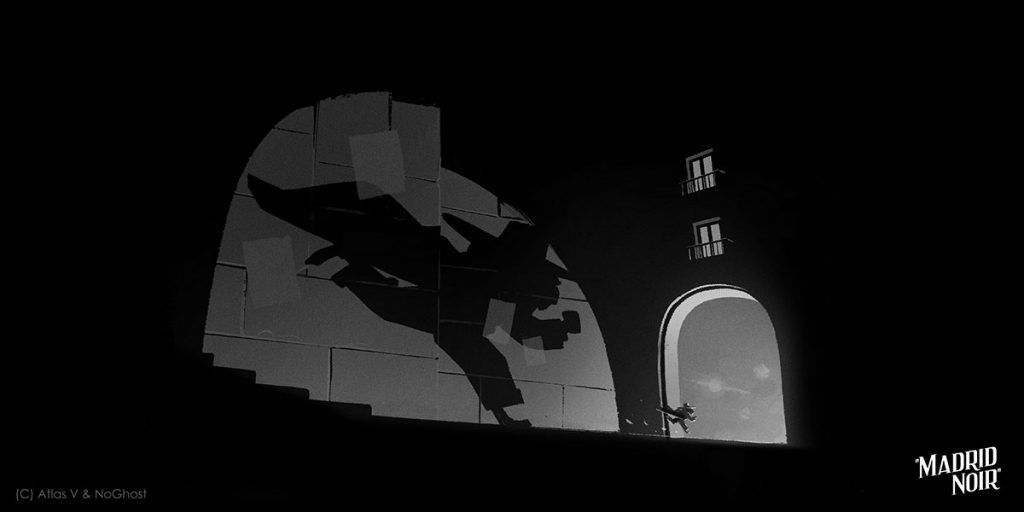
A few scenes are in black and white, which I loved! All the text popping up and those very specific shapes made by the cigarette smoke… It felt like a graphic novel to me!
JC: The lighting and the black and white just make everything feel so different: at the beginning, I was like, “the whole thing has to be black and white”. I remember producers were like, … “no.” [laughs] But there’s a flashback that’s in black and white. As for the text, for example, all the “tap, tap taps” and the line work, all of these things came from myself and Juancho [Capic], the art director: we’ve been friends since we were kids, and we grew up in Spain, where there’s this massive comic book culture. It’s called bande dessinée, this specific French type of comic book: Tintin belongs to that too. We are massive fans, so, from the very beginning, we were always writing these sounds, like the “tap, taps” and the “bangs” and so on, on the concept art: it’s something that, for us, is very pleasing aesthetically. It took us a while to find the balance of how much text was too much: at one point, we had little “woof” pop up whenever the dog, Paquita, barked, and then we realised that it just became extremely annoying, because it was always coming out of her mouth, and it was very distracting. So we had to select which moments would have a word appear, so as to use them in a way that felt somatically appropriate.
For example, there’s this scene where Lola annoys Manolo in the house: Manolo is typing, and the “tap taps” are tiny. And then, when he’s angry, the “taps” are massive. It’s a way to add these elements that are aesthetically pleasing while also making sure that they keep telling the story. It’s the same with the lines made by the cigarette smoke, and on the steps on the floor. We always knew that we wanted to have some graphic elements that would also help and guide the audience.
Challenges, Casting and Creative Process
What were the main challenges when bringing Madrid Noir to life?
JC: Nobody wants to hear more stuff about COVID, but I would be lying if I said that COVID itself hadn’t been our biggest challenge. Because we do animation, and we come from an industry where people are very used to freelancing, we’re lucky, as everybody was able to work from home. So, once COVID hit, we were back to production as usual within a week. In that regard, it wasn’t ideal, but it was okay. But then, in terms of organisation, communication was difficult, because there was one point where we had 35-40 people in production, and it was very hard to make sure that nothing fell through the cracks. So much can go wrong in in making a project like this, because, on a normal production, you’d go from department to department, right? You storyboard a shot, you animate it, and then you render the shot and put music and sound to it, and it’s done. But here, everything has to be done at the same time, and everything has to be perfect.
How did you come to cast Godeliv Van Den Brandt as Lola?
JC: We couldn’t travel to the US, and nobody could come to England, so it was difficult to find the right person to play Lola. It was one of those situations where, out of the storm, a beam of light just came from the clouds. Godeliv is an amazing talent: she ticked every box. It was still complicated: the logistics of it were quite tricky because of COVID. But then, as a first time director, I gotta say, recording actors for something that you’ve written is the most fun thing in the world.
How come?
JC: When you write and design a character, you have nothing but your imagination to read the lines and to imagine what that character would sound like. I had never collaborated with a performer before, in any creative capacity. All of a sudden, somebody that is emotionally invested in a story that you’ve written, which is already a very surreal thing, reads the lines with a tone or with an intention that you never thought of. And you’re like, Oh my god, that’s so much better. That’s the most beautiful thing about the creative process: every time you pass the ball to the next creative person, they just make it more beautiful. And then, when it all comes back to you, you’re like, this is so much better than what I could have done on my own.
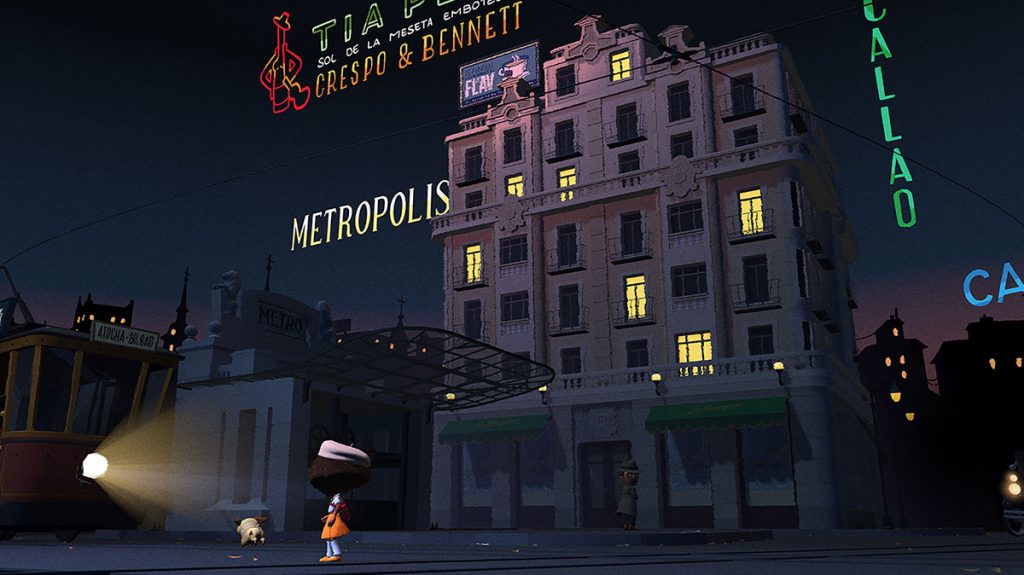
What’s Next for James A. Castillo and Madrid Noir
What’s next for you?
JC: I need a bit of a break. But after that, I’m really looking forward to keeping developing animated projects. The relationship between Atlas V, No Ghost and myself has been very nice and easy, and we’ve been able to communicate through a lot of things. We don’t want to scratch the idea that we couldn’t collaborate on other projects together again. But I also want to try and maybe develop other projects, and see what the limits are: I think, right now, the animation industry can create a lot of content that a lot of brands are extremely interested in. So, if I can take some of the things that I’ve learned making Madrid Noir, in terms of interaction and genre aesthetics, and bring them into a TV show or a movie, or a short, or something like that, that would be very interesting. At the moment, I just want to keep writing and develop more projects, and to keep collaborating with people that I admire.
And when will we be able to see Madrid Noir?
JC: Soon! It comes out on the Oculus Quest worldwide on July 1st.
Good luck with the festival run!
JC: Thank you. As much as I’m frustrated by the fact that I can’t go to see people’s faces when they see the project and be at the festival, and talk to people like you in person, I’m just really happy that people will get to see it, and to celebrate it with the team: everybody is very proud of the work we’ve done. With COVID, it’s been hard to be able to celebrate, because we can’t go out, but hopefully, by July 1st, we should be able to see everybody and do a proper wrap party. At the end of the day, the attention is nice, but to be able to celebrate with all the people that have given a year of their lives to make this, that’s much more fulfilling.
This interview has been edited for length and clarity.
Madrid Noir had its World Premiere at the 2021 Tribeca Film Festival, and is also being showcased at the Annecy International Animation Film Festival this week, before it becomes available on the Oculus Quest Store worldwide on July 1st.

